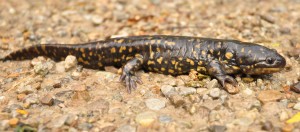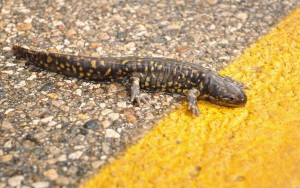Photography courtesy of Lowell Washburn, all rights reserved.
It would be hard for anyone to miss this annual spectacle. If you’ve been out and about during recent rainy days, you’ve undoubtedly seen it for yourself — scores of tiger salamanders solemnly marching over hill and dale toward winter quarters.
Although most wildlife migrations occur in the heavens, the annual passage of salamanders takes place on land. Instead of utilizing wing power, this mass movement employs all terrain, four wheel drive, feet on the ground locomotion.
As is the case with all amphibians, tiger salamanders depend on wetlands for survival. In the spring, tigers congregate to mate and lay their eggs in shallow ponds and marshes. Once the task is complete, adults return to the uplands where they go completely nocturnal and disappear until fall. Hatchlings spend the summer as gilled larvae [salamander tadpoles] and emerge as adults at season‘s end.
During the blistering summer drought cycles of 2011 and 2012, there was little if any successful reproduction. During the fall of 2013, there were no spectacular migrations. Most of us, in fact, did not see so much as a single salamander during the entire fall.
But this year, the water is back and so are the tigers. The first big statewide movement occurred on September 20th as a steady rainfall literally brought salamanders out of the woodwork. From McGregor to Okoboji, Davenport to Council Bluffs; thousands upon thousands of adult salamanders were seen lumbering across county blacktops and rural gravel roadways. [Less spectacular migrations will continue to occur following each new rainfall from now through early November.] Although the migration has been dominated by younger animals, a large number of older adults are appearing as well. This is amazing. Salamanders spend the winter hibernating in moist underground burrows and you have to wonder how they managed to survive the powder dry rigors of the prolonged drought.
But there’s no mystery as to why wildlife watchers are rightfully excited over this year’s bumper crop of amphibians. The appearance of young salamanders is a sign of healthy wetlands nearby. Wetland habitats that are good for tiger salamanders also provide benefits to everything from mallard ducks to painted turtles, and from mink to marsh wrens.
Wetlands are good for the human spirit as well. They provide quality recreation, display the wonders of Creation, filter and cleanse our surface waters, and help to recharge underground aquifers. And that should make this year’s spectacular salamander migration of interest to everyone.
LW


![1] tiger salamander larvae](https://iawildlife.org/wp-content/uploads/2014/10/1-tiger-salamander-larvae-300x196.jpg)


 Tom Cope
Tom Cope Sue Wilkinson
Sue Wilkinson Susan Judkins Josten
Susan Judkins Josten Rudi Roeslein
Rudi Roeslein Elyssa McFarland
Elyssa McFarland Mark Langgin
Mark Langgin Adam Janke
Adam Janke Joe Henry
Joe Henry Kristin Ashenbrenner
Kristin Ashenbrenner Joe Wilkinson
Joe Wilkinson Dr. Tammy Mildenstein
Dr. Tammy Mildenstein Sean McMahon
Sean McMahon